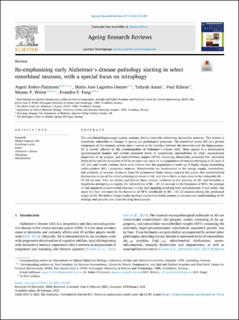| dc.contributor.author | Kobro-Flatmoen, Asgeir | |
| dc.contributor.author | Lagartos-Donate, Maria Jose | |
| dc.contributor.author | Aman, Yahyah | |
| dc.contributor.author | Edison, Paul | |
| dc.contributor.author | Witter, Menno | |
| dc.contributor.author | Fang, Fei | |
| dc.date.accessioned | 2021-04-22T09:00:41Z | |
| dc.date.available | 2021-04-22T09:00:41Z | |
| dc.date.created | 2021-04-19T00:17:37Z | |
| dc.date.issued | 2021 | |
| dc.identifier.citation | Ageing Research Reviews. 2021, 67:101307 1-17. | en_US |
| dc.identifier.issn | 1568-1637 | |
| dc.identifier.uri | https://hdl.handle.net/11250/2739032 | |
| dc.description.abstract | The entorhinal-hippocampal system contains distinct networks subserving declarative memory. This system is selectively vulnerable to changes of ageing and pathological processes. The entorhinal cortex (EC) is a pivotal component of this memory system since it serves as the interface between the neocortex and the hippocampus. EC is heavily affected by the proteinopathies of Alzheimer’s disease (AD). These appear in a stereotypical spatiotemporal manner and include increased levels of intracellular amyloid-beta Aβ (iAβ), parenchymal deposition of Aβ plaques, and neurofibrillary tangles (NFTs) containing abnormally processed Tau. Increased levels of iAβ and the formation of NFTs are seen very early on in a population of neurons belonging to EC layer II (EC LII), and recent evidence leads us to believe that this population is made up of highly energy-demanding reelin-positive (RE+) projection neurons. Mitochondria are fundamental to the energy supply, metabolism, and plasticity of neurons. Evidence from AD postmortem brain tissues supports the notion that mitochondrial dysfunction is one of the initial pathological events in AD, and this is likely to take place in the vulnerable RE + EC LII neurons. Here we review and discuss these notions, anchored to the anatomy of AD, and formulate a hypothesis attempting to explain the vulnerability of RE + EC LII neurons to the formation of NFTs. We attempt to link impaired mitochondrial clearance to iAβ and signaling involving both apolipoprotein 4 and reelin, and argue for their relevance to the formation of NFTs specifically in RE + EC LII neurons during the prodromal stages of AD. We believe future studies on these interactions holds promise to advance our understanding of AD etiology and provide new ideas for drug development. | en_US |
| dc.language.iso | eng | en_US |
| dc.publisher | Elsevier | en_US |
| dc.rights | Navngivelse 4.0 Internasjonal | * |
| dc.rights.uri | http://creativecommons.org/licenses/by/4.0/deed.no | * |
| dc.title | Re-emphasizing early Alzheimer's disease pathology starting in select entorhinal neurons, with a special focus on mitophagy | en_US |
| dc.type | Peer reviewed | en_US |
| dc.type | Journal article | en_US |
| dc.description.version | publishedVersion | en_US |
| dc.source.pagenumber | 1-17 | en_US |
| dc.source.volume | 67:101307 | en_US |
| dc.source.journal | Ageing Research Reviews | en_US |
| dc.identifier.doi | 10.1016/j.arr.2021.101307 | |
| dc.identifier.cristin | 1904957 | |
| dc.description.localcode | © 2021 The Author(s). Published by Elsevier B.V. This is an open access article under the CC BY license (http://creativecommons.org/licenses/by/4.0/). | en_US |
| cristin.ispublished | true | |
| cristin.fulltext | original | |
| cristin.qualitycode | 1 | |

